Motorola LS3478 User Manual
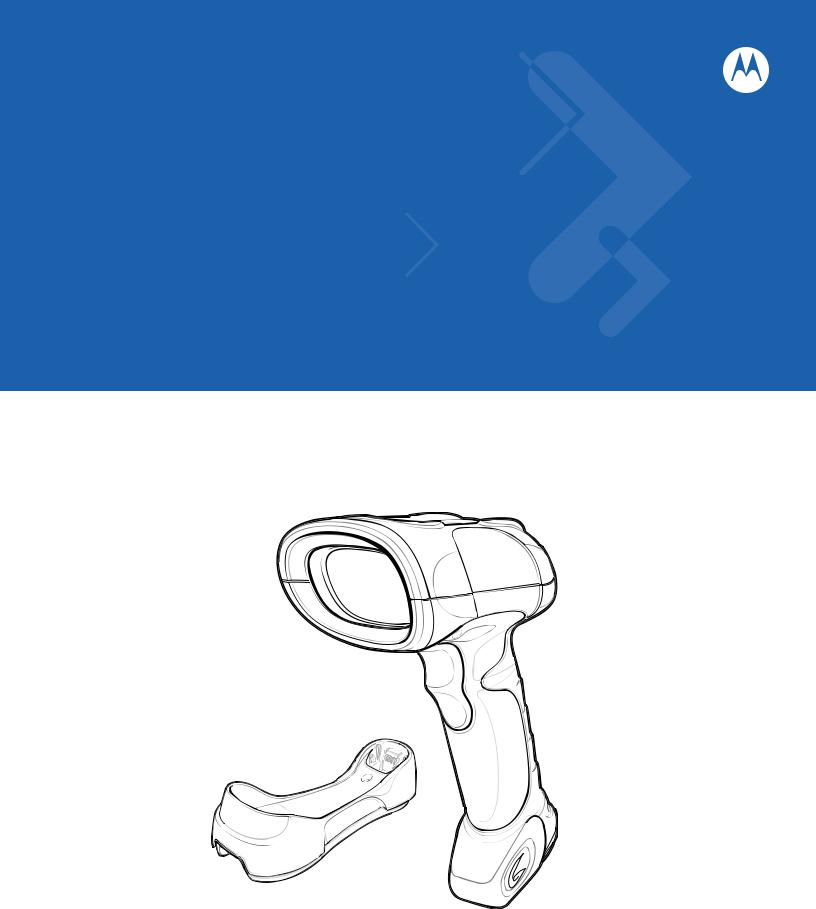
Symbol LS3478
Product Reference Guide
Symbol LS3478
Product Reference Guide
72E-67139-03
Revision A
July 2007

ii Symbol LS3478 Product Reference Guide
© 2007 by Motorola, Inc. All rights reserved.
No part of this publication may be reproduced or used in any form, or by any electrical or mechanical means, without permission in writing from Motorola. This includes electronic or mechanical means, such as photocopying, recording, or information storage and retrieval systems. The material in this manual is subject to change without notice.
The software is provided strictly on an “as is” basis. All software, including firmware, furnished to the user is on a licensed basis. Motorola grants to the user a non-transferable and non-exclusive license to use each software or firmware program delivered hereunder (licensed program). Except as noted below, such license may not be assigned, sublicensed, or otherwise transferred by the user without prior written consent of Motorola. No right to copy a licensed program in whole or in part is granted, except as permitted under copyright law. The user shall not modify, merge, or incorporate any form or portion of a licensed program with other program material, create a derivative work from a licensed program, or use a licensed program in a network without written permission from Motorola. The user agrees to maintain Motorola’s copyright notice on the licensed programs delivered hereunder, and to include the same on any authorized copies it makes, in whole or in part. The user agrees not to decompile, disassemble, decode, or reverse engineer any licensed program delivered to the user or any portion thereof.
Motorola reserves the right to make changes to any software or product to improve reliability, function, or design.
Motorola does not assume any product liability arising out of, or in connection with, the application or use of any product, circuit, or application described herein.
No license is granted, either expressly or by implication, estoppel, or otherwise under any Motorola, Inc., intellectual property rights. An implied license only exists for equipment, circuits, and subsystems contained in Motorola products.
MOTOROLA and the Stylized M Logo and Symbol and the Symbol logo are registered in the US Patent & Trademark Office. Bluetooth is a registered trademark of Bluetooth SIG. Microsoft, Windows and ActiveSync are either registered trademarks or trademarks of Microsoft Corporation. All other product or service names are the property of their respective owners.
Motorola, Inc.
One Motorola Plaza
Holtsville, New York 11742-1300
http://www.symbol.com
Patents
This product is covered by one or more of the patents listed on the website: www.symbol.com/patents.

iii
Revision History
Changes to the original manual are listed below:
Change |
Date |
Description |
|
|
|
-01 Rev A |
2/2005 |
Initial release. |
|
|
|
-02 Rev A |
2/2007 |
Update service information, correct Symbol PTC Terminal bar code, specify that |
|
|
multipoint mode does not support Beep on BEL. |
|
|
|
-03 Rev A |
7/2007 |
Motorola rebranding; added Battery Maintenance information in Chapter 3. |
|
|
|

iv Symbol LS3478 Product Reference Guide

Table of Contents
About This Guide |
|
Introduction .................................................................................................................... |
xiii |
Chapter Descriptions ..................................................................................................... |
xiii |
Notational Conventions.................................................................................................. |
xiv |
Related Publications ...................................................................................................... |
xiv |
Service Information........................................................................................................ |
xv |
Chapter 1: Getting Started |
|
Introduction ................................................................................................................... |
1-1 |
Unpacking the Scanner ................................................................................................ |
1-2 |
The Scanner Cradle ...................................................................................................... |
1-2 |
Cradle Parts ............................................................................................................ |
1-3 |
Connecting the Cradle ............................................................................................ |
1-4 |
Supplying Power to the Cradle ............................................................................... |
1-5 |
Connecting a Synapse Cable Interface .................................................................. |
1-6 |
Lost Connection to Host .......................................................................................... |
1-6 |
Mounting the Cradle ................................................................................................ |
1-6 |
Inserting the Battery ...................................................................................................... |
1-7 |
Removing the Battery ............................................................................................. |
1-7 |
Charging the Battery ..................................................................................................... |
1-8 |
Charging LED ......................................................................................................... |
1-8 |
Charging Problem LED ........................................................................................... |
1-8 |
Inserting the Scanner in the Cradle .............................................................................. |
1-9 |
Pairing ........................................................................................................................... |
1-9 |
Unpairing ................................................................................................................. |
1-10 |
Configuring the Scanner ............................................................................................... |
1-10 |
vi |
Symbol LS3478 Product Reference Guide |
|
|
|
|
Chapter 2: Scanning |
|
|
|
Introduction ................................................................................................................... |
2-1 |
|
Beeper Definitions ........................................................................................................ |
2-2 |
|
LED Definitions ............................................................................................................. |
2-3 |
|
Scanning ....................................................................................................................... |
2-4 |
|
Aiming ..................................................................................................................... |
2-5 |
|
Decode Zone ................................................................................................................ |
2-6 |
Chapter 3: Maintenance and Technical Specifications |
|
|
|
Introduction ................................................................................................................... |
3-1 |
|
Maintenance ................................................................................................................. |
3-1 |
|
Battery Maintenance ............................................................................................... |
3-1 |
|
Troubleshooting ............................................................................................................ |
3-2 |
|
Technical Specifications ............................................................................................... |
3-5 |
|
Scanner Signal Descriptions ......................................................................................... |
3-8 |
Chapter 4: User Preferences |
|
|
|
Introduction ................................................................................................................... |
4-1 |
|
Scanning Sequence Examples ..................................................................................... |
4-2 |
|
Errors While Scanning .................................................................................................. |
4-2 |
|
User Preferences Default Parameters .......................................................................... |
4-2 |
|
User Preferences .......................................................................................................... |
4-3 |
|
Set Default Parameter ............................................................................................ |
4-3 |
|
Beeper Tone ........................................................................................................... |
4-3 |
|
Beeper Volume ....................................................................................................... |
4-4 |
|
Power Mode ............................................................................................................ |
4-5 |
|
Laser On Time ........................................................................................................ |
4-5 |
|
Beep After Good Decode ........................................................................................ |
4-6 |
|
Trigger Mode ........................................................................................................... |
4-7 |
|
Aim Duration ........................................................................................................... |
4-8 |
|
Radio Communications ................................................................................................. |
4-9 |
|
Connection Maintenance Interval ........................................................................... |
4-9 |
|
Radio Output Power ................................................................................................ |
4-11 |
|
Parameter Broadcast .............................................................................................. |
4-11 |
|
Single Point/Multipoint Operation ............................................................................ |
4-12 |
Chapter 5: Keyboard Wedge Interface |
|
|
|
Introduction ................................................................................................................... |
5-1 |
|
Connecting a Keyboard Wedge Interface ..................................................................... |
5-2 |
|
Keyboard Wedge Default Parameters .......................................................................... |
5-3 |
|
Keyboard Wedge Host Types ....................................................................................... |
5-4 |
|
Keyboard Wedge Host Types ................................................................................. |
5-4 |
|
Keyboard Wedge Country Types (Country Codes) ................................................ |
5-5 |
|
Ignore Unknown Characters ................................................................................... |
5-7 |
|
Keystroke Delay ...................................................................................................... |
5-7 |
|
Intra-Keystroke Delay ............................................................................................. |
5-8 |
|
Alternate Numeric Keypad Emulation ..................................................................... |
5-8 |
|
Table of Contents |
vii |
|
|
|
Caps Lock On ......................................................................................................... |
5-8 |
|
Caps Lock Override ................................................................................................ |
5-9 |
|
Convert Wedge Data .............................................................................................. |
5-9 |
|
Function Key Mapping ............................................................................................ |
5-10 |
|
FN1 Substitution ..................................................................................................... |
5-10 |
|
Send Make and Break ............................................................................................ |
5-10 |
|
Keyboard Maps ............................................................................................................. |
5-11 |
|
ASCII Character Set ..................................................................................................... |
5-13 |
|
Chapter 6: RS-232 Interface |
|
|
Introduction ................................................................................................................... |
6-1 |
|
Connecting an RS-232 Interface .................................................................................. |
6-2 |
|
RS-232 Default Parameters .......................................................................................... |
6-3 |
|
RS-232 Host Parameters .............................................................................................. |
6-4 |
|
RS-232 Host Types ................................................................................................. |
6-6 |
|
Baud Rate ............................................................................................................... |
6-7 |
|
Parity ....................................................................................................................... |
6-9 |
|
Check Receive Errors ............................................................................................. |
6-10 |
|
Stop Bit Select ........................................................................................................ |
6-11 |
|
Data Bits ................................................................................................................. |
6-11 |
|
Hardware Handshaking .......................................................................................... |
6-12 |
|
Software Handshaking ............................................................................................ |
6-14 |
|
Host Serial Response Time-out .............................................................................. |
6-16 |
|
RTS Line State ........................................................................................................ |
6-17 |
|
Beep on <BEL> ....................................................................................................... |
6-17 |
|
Intercharacter Delay ................................................................................................ |
6-18 |
|
Nixdorf Mode A/B and OPOS/JPOS Beep/LED Options ........................................ |
6-19 |
|
Ignore Unknown Characters ................................................................................... |
6-20 |
|
ASCII / Character Set ................................................................................................... |
6-21 |
|
Chapter 7: USB Interface |
|
|
Introduction ................................................................................................................... |
7-1 |
|
Connecting a USB Interface ......................................................................................... |
7-1 |
|
USB Default Parameters .............................................................................................. |
7-3 |
|
USB Host Parameters .................................................................................................. |
7-4 |
|
USB Device Type .................................................................................................... |
7-4 |
|
USB Country Keyboard Types (Country Codes) .................................................... |
7-5 |
|
USB Keystroke Delay ............................................................................................. |
7-7 |
|
USB Caps Lock Override ........................................................................................ |
7-8 |
|
USB Ignore Unknown Characters ........................................................................... |
7-8 |
|
Emulate Keypad ...................................................................................................... |
7-9 |
|
USB Keyboard FN 1 Substitution ............................................................................ |
7-9 |
|
Function Key Mapping ............................................................................................ |
7-10 |
|
Simulated Caps Lock .............................................................................................. |
7-10 |
|
Convert Case .......................................................................................................... |
7-11 |
|
ASCII Character Set ..................................................................................................... |
7-12 |
|
viii |
Symbol LS3478 Product Reference Guide |
|
|
|
|
Chapter 8: IBM 468X/469X Interface |
|
|
|
Introduction ................................................................................................................... |
8-1 |
|
Connecting to an IBM 468X/469X Host ........................................................................ |
8-2 |
|
IBM Default Parameters ............................................................................................... |
8-3 |
|
IBM 468X/469X Host Parameters ................................................................................. |
8-4 |
|
Port Address ........................................................................................................... |
8-4 |
|
Convert Unknown to Code 39 ................................................................................. |
8-4 |
Chapter 9: Wand Emulation Interface |
|
|
|
Introduction ................................................................................................................... |
9-1 |
|
Connecting a Wand Emulation Interface ...................................................................... |
9-2 |
|
Wand Emulation Default Parameters ........................................................................... |
9-3 |
|
Wand Emulation Host Parameters ............................................................................... |
9-4 |
|
Wand Emulation Host Types .................................................................................. |
9-4 |
|
Leading Margin (Quiet Zone) .................................................................................. |
9-5 |
|
Polarity .................................................................................................................... |
9-5 |
|
Ignore Unknown Characters ................................................................................... |
9-6 |
|
Convert All to Code 39 ............................................................................................ |
9-6 |
|
Convert Code 39 to Full ASCII ............................................................................... |
9-7 |
Chapter 10: Scanner Emulation Interface |
|
|
|
Introduction ................................................................................................................... |
10-1 |
|
Connecting Using Scanner Emulation .......................................................................... |
10-2 |
|
Scanner Emulation Default Parameters ....................................................................... |
10-3 |
|
Scanner Emulation Host ............................................................................................... |
10-4 |
|
Scanner Emulation Host Parameters ........................................................................... |
10-5 |
|
Beep Style ............................................................................................................... |
10-5 |
|
Parameter Pass-Through ........................................................................................ |
10-6 |
|
Convert Newer Code Types .................................................................................... |
10-7 |
|
Module Width .......................................................................................................... |
10-7 |
|
Convert All Bar Codes to Code 39 .......................................................................... |
10-8 |
|
Code 39 Full ASCII Conversion .............................................................................. |
10-8 |
|
Transmission Timeout ............................................................................................. |
10-9 |
|
Ignore Unknown Characters ................................................................................... |
10-10 |
|
Leading Margin ....................................................................................................... |
10-11 |
|
Check for Decode LED ........................................................................................... |
10-12 |
Chapter 11: 123Scan |
|
|
|
Introduction ................................................................................................................... |
11-1 |
|
Setting Up 123Scan ...................................................................................................... |
11-1 |
Chapter 12: Symbologies |
|
|
|
Introduction ................................................................................................................... |
12-1 |
|
Scanning Sequence Examples ..................................................................................... |
12-1 |
|
Errors While Scanning .................................................................................................. |
12-1 |
|
Symbology Default Parameters .................................................................................... |
12-2 |
|
Table of Contents |
ix |
|
|
|
UPC/EAN ...................................................................................................................... |
12-5 |
|
Enable/Disable UPC-A ............................................................................................ |
12-5 |
|
Enable/Disable UPC-E ............................................................................................ |
12-5 |
|
Enable/Disable UPC-E1 .......................................................................................... |
12-6 |
|
Enable/Disable EAN-13 .......................................................................................... |
12-6 |
|
Enable/Disable EAN-8 ............................................................................................ |
12-7 |
|
Enable/Disable Bookland EAN ............................................................................... |
12-7 |
|
Decode UPC/EAN/JAN Supplementals .................................................................. |
12-8 |
|
UPC/EAN/JAN Supplemental Redundancy ............................................................ |
12-10 |
|
Transmit UPC-A/UPC-E/UPC-E1 Check Digit ........................................................ |
12-10 |
|
UPC-A Preamble .................................................................................................... |
12-12 |
|
UPC-E Preamble .................................................................................................... |
12-13 |
|
UPC-E1 Preamble .................................................................................................. |
12-14 |
|
Convert UPC-E to UPC-A ....................................................................................... |
12-15 |
|
Convert UPC-E1 to UPC-A ..................................................................................... |
12-16 |
|
EAN-8/JAN-8 Extend .............................................................................................. |
12-17 |
|
Code 128 ...................................................................................................................... |
12-17 |
|
Enable/Disable Code 128 ....................................................................................... |
12-17 |
|
Enable/Disable UCC/EAN-128 ............................................................................... |
12-18 |
|
Enable/Disable ISBT 128 ........................................................................................ |
12-18 |
|
Code 39 ........................................................................................................................ |
12-19 |
|
Enable/Disable Code 39 ......................................................................................... |
12-19 |
|
Enable/Disable Trioptic Code 39 ............................................................................ |
12-19 |
|
Convert Code 39 to Code 32 .................................................................................. |
12-20 |
|
Code 32 Prefix ........................................................................................................ |
12-20 |
|
Set Lengths for Code 39 ......................................................................................... |
12-21 |
|
Code 39 Check Digit Verification ............................................................................ |
12-22 |
|
Transmit Code 39 Check Digit ................................................................................ |
12-22 |
|
Code 39 Full ASCII Conversion .............................................................................. |
12-23 |
|
Code 93 ........................................................................................................................ |
12-24 |
|
Enable/Disable Code 93 ......................................................................................... |
12-24 |
|
Set Lengths for Code 93 ......................................................................................... |
12-24 |
|
Code 11 ........................................................................................................................ |
12-26 |
|
Code 11 .................................................................................................................. |
12-26 |
|
Set Lengths for Code 11 ......................................................................................... |
12-27 |
|
Code 11 Check Digit Verification ............................................................................ |
12-28 |
|
Transmit Code 11 Check Digits .............................................................................. |
12-29 |
|
Interleaved 2 of 5 (I 2 of 5) ............................................................................................ |
12-30 |
|
Enable/Disable Interleaved 2 of 5 ........................................................................... |
12-30 |
|
Set Lengths for Interleaved 2 of 5 ........................................................................... |
12-30 |
|
I 2 of 5 Check Digit Verification ............................................................................... |
12-32 |
|
Transmit I 2 of 5 Check Digit ................................................................................... |
12-32 |
|
Convert I 2 of 5 to EAN-13 ...................................................................................... |
12-33 |
|
Discrete 2 of 5 (D 2 of 5) ............................................................................................... |
12-34 |
|
Enable/Disable Discrete 2 of 5 ................................................................................ |
12-34 |
|
Set Lengths for Discrete 2 of 5 ............................................................................... |
12-35 |
|
Codabar (NW - 7) ......................................................................................................... |
12-36 |
|
Enable/Disable Codabar ......................................................................................... |
12-36 |
|
Set Lengths for Codabar ......................................................................................... |
12-37 |
|
CLSI Editing ............................................................................................................ |
12-38 |
|
x |
Symbol LS3478 Product Reference Guide |
|
|
|
|
|
NOTIS Editing ......................................................................................................... |
12-38 |
|
MSI ............................................................................................................................... |
12-39 |
|
Enable/Disable MSI ................................................................................................ |
12-39 |
|
Set Lengths for MSI ................................................................................................ |
12-40 |
|
MSI Check Digits .................................................................................................... |
12-41 |
|
Transmit MSI Check Digit(s) ................................................................................... |
12-42 |
|
MSI Check Digit Algorithm ...................................................................................... |
12-42 |
|
GS1 DataBar ................................................................................................................ |
12-43 |
|
GS1 DataBar-14 ..................................................................................................... |
12-43 |
|
GS1 DataBar Limited .............................................................................................. |
12-43 |
|
GS1 DataBar Expanded ......................................................................................... |
12-43 |
|
Convert GS1 DataBar to UPC/EAN ........................................................................ |
12-44 |
|
Redundancy Level ........................................................................................................ |
12-45 |
|
Redundancy Level 1 ............................................................................................... |
12-45 |
|
Redundancy Level 2 ............................................................................................... |
12-45 |
|
Redundancy Level 3 ............................................................................................... |
12-46 |
|
Redundancy Level 4 ............................................................................................... |
12-46 |
|
Security Level ............................................................................................................... |
12-47 |
|
Security Level 0 ...................................................................................................... |
12-47 |
|
Security Level 1 ...................................................................................................... |
12-47 |
|
Security Level 2 ...................................................................................................... |
12-47 |
|
Security Level 3 ...................................................................................................... |
12-47 |
|
Bi-directional Redundancy ............................................................................................ |
12-48 |
Chapter 13: Miscellaneous Scanner Options |
|
|
|
Introduction ................................................................................................................... |
13-1 |
|
Scanning Sequence Examples ..................................................................................... |
13-1 |
|
Errors While Scanning .................................................................................................. |
13-1 |
|
Miscellaneous Default Parameters ............................................................................... |
13-2 |
|
Miscellaneous Scanner Parameters ............................................................................. |
13-3 |
|
Transmit Code ID Character ................................................................................... |
13-3 |
|
Scan Angle .............................................................................................................. |
13-3 |
|
Prefix/Suffix Values ................................................................................................. |
13-4 |
|
Scan Data Transmission Format ............................................................................ |
13-5 |
|
FN1 Substitution Values ......................................................................................... |
13-7 |
|
Transmit “No Read” Message ................................................................................. |
13-7 |
|
Synapse Interface ................................................................................................... |
13-8 |
Chapter 14: Advanced Data Formatting |
|
|
|
Introduction ................................................................................................................... |
14-1 |
|
Rules: Criteria Linked to Actions ................................................................................... |
14-1 |
|
Using ADF Bar Codes .................................................................................................. |
14-2 |
|
ADF Bar Code Menu Example ..................................................................................... |
14-2 |
|
Rule 1: The Code 128 Scanning Rule .................................................................... |
14-3 |
|
Rule 2: The UPC Scanning Rule ............................................................................ |
14-3 |
|
Alternate Rule Sets ................................................................................................. |
14-3 |
|
Rules Hierarchy (in Bar Codes) .............................................................................. |
14-4 |
|
Default Rules .......................................................................................................... |
14-5 |
|
Table of Contents |
xi |
|
|
|
Special Considerations for Multipoint Networks ...................................................... |
14-5 |
|
Special Commands ....................................................................................................... |
14-6 |
|
Pause Duration ....................................................................................................... |
14-6 |
|
Begin New Rule ...................................................................................................... |
14-6 |
|
Save Rule ............................................................................................................... |
14-6 |
|
Erase ....................................................................................................................... |
14-7 |
|
Quit Entering Rules ................................................................................................. |
14-7 |
|
Disable Rule Set ..................................................................................................... |
14-8 |
|
Criteria .......................................................................................................................... |
14-9 |
|
Code Types ............................................................................................................. |
14-9 |
|
Code Lengths .......................................................................................................... |
14-12 |
|
Message Containing A Specific Data String ........................................................... |
14-16 |
|
Actions .......................................................................................................................... |
14-20 |
|
Send Data ............................................................................................................... |
14-20 |
|
Setup Field(s) .......................................................................................................... |
14-23 |
|
Modify Data ............................................................................................................. |
14-29 |
|
Pad Data with Spaces ............................................................................................. |
14-30 |
|
Pad Data with Zeros ............................................................................................... |
14-34 |
|
Beeps ...................................................................................................................... |
14-38 |
|
Send Keystroke (Control Characters and Keyboard Characters) ........................... |
14-39 |
|
Send Right Control Key .......................................................................................... |
14-71 |
|
Send Graphic User Interface (GUI) Characters ...................................................... |
14-71 |
|
Turn On/Off Rule Sets ............................................................................................ |
14-77 |
|
Alphanumeric Keyboard ............................................................................................... |
14-78 |
|
Appendix A: Standard Default Parameters |
|
|
Appendix B: Programming Reference |
|
|
Symbol Code Identifiers ................................................................................................ |
B-1 |
|
AIM Code Identifiers ..................................................................................................... |
B-2 |
|
Appendix C: Sample Bar Codes |
|
|
UPC-A ........................................................................................................................... |
C-1 |
|
UPC-E ........................................................................................................................... |
C-1 |
|
UPC-E1 ......................................................................................................................... |
C-1 |
|
EAN-13 ......................................................................................................................... |
C-2 |
|
EAN-8 ........................................................................................................................... |
C-2 |
|
Code 39 ........................................................................................................................ |
C-2 |
|
Trioptic Code 39 ........................................................................................................... |
C-2 |
|
Code 93 ........................................................................................................................ |
C-3 |
|
Code 11 ........................................................................................................................ |
C-3 |
|
Codabar ........................................................................................................................ |
C-3 |
|
MSI ............................................................................................................................... |
C-3 |
|
Interleaved 2 of 5 .......................................................................................................... |
C-4 |
|
xii |
Symbol LS3478 Product Reference Guide |
|
|
|
|
Appendix D: Numeric Bar Codes |
|
|
|
0, 1, 2, 3 ........................................................................................................................ |
D-1 |
|
4, 5, 6, 7 ........................................................................................................................ |
D-2 |
|
8, 9 ................................................................................................................................ |
D-3 |
|
Cancel ........................................................................................................................... |
D-3 |
Glossary
Index
Tell Us What You Think...

About This Guide
Introduction
The Symbol LS3478 Product Reference Guide provides general instructions for setting up, operating, maintaining, and troubleshooting the scanner. The Symbol LS3478 includes the following variations of the scanner:
•LS3478-FZ: 1-D scanning
•LS3478-ER: extended range 1-D scanning.
Chapter Descriptions
•Chapter 1, Getting Started provides a product overview and unpacking instructions.
•Chapter 2, Scanning describes parts of the scanner, beeper and LED definitions, and how to use the scanner.
•Chapter 3, Maintenance and Technical Specifications provides information on how to care for the scanner, troubleshooting, and technical specifications.
•Chapter 4, User Preferences provides the programming bar codes necessary for selecting user preference features for the scanner.
•Chapter 5, Keyboard Wedge Interface provides information for setting up the scanner for keyboard wedge operation.
•Chapter 6, RS-232 Interface provides information for setting up the scanner for RS-232 operation.
•Chapter 7, USB Interface provides information for setting up the scanner for USB operation.
•Chapter 8, IBM 468X/469X Interface provides information for setting up the scanner with IBM 468X/469X POS systems.
•Chapter 9, Wand Emulation Interface provides information for setting up the scanner for wand emulation operation.
•Chapter 10, Scanner Emulation Interface provides information for setting up the scanner for scanner emulation operation.
•Chapter 11, 123Scan provides information on the PC-based scanner configuration tool 123Scan.

xivSymbol LS3478 Product Reference Guide
•Chapter 12, Symbologies describes all symbology features and provides the programming bar codes for selecting these features.
•Chapter 13, Miscellaneous Scanner Options includes commonly used bar codes to customize how data is transmitted to the host device.
•Chapter 14, Advanced Data Formatting (ADF) describes how to customize scanned data before transmitting to the host.
•Appendix A, Standard Default Parameters provides a table of all host devices and miscellaneous scanner defaults.
•Appendix B, Programming Reference provides a table of AIM code identifiers, ASCII character conversions, and keyboard maps.
•Appendix C, Sample Bar Codes includes sample bar codes.
•Appendix D, Numeric Bar Codes includes the numeric bar codes to scan for parameters requiring specific numeric values.
Notational Conventions
The following conventions are used in this document:
•Bullets (•) indicate:
•action items
•lists of alternatives
•lists of required steps that are not necessarily sequential.
•Sequential lists (e.g., those that describe step-by-step procedures) appear as numbered lists.
•Throughout the programming bar code menus, asterisks (*) are used to denote default parameter settings.
* Indicates Default *Baud Rate 9600
*Baud Rate 9600 
 Feature/Option
Feature/Option
Related Publications
The LS3478 Quick Start Guide (p/n 72-67137-xx) provides general information to help the user get started with the scanner, including basic setup and operation instructions.
For the latest versions of the LS3478 Quick Start Guide and the Symbol LS3478 Product Reference Guide go to: http://support.symbol.com.

About This Guide xv
Service Information
If you have a problem with your equipment, contact Motorola Enterprise Mobility Support for your region. Go to http://www.symbol.com/contactsupport. If you purchased your Motorola product from a Motorola Business Partner, contact that Business Partner for service.
Before contacting, have the model number and serial number at hand. If your problem cannot be solved by the Motorola Enterprise Mobility Support, you may need to return your equipment for servicing and you will be given specific directions.
Motorola is not responsible for any damages incurred during shipment if the approved shipping container is not used. Shipping the units improperly can possibly void the warranty.

xvi Symbol LS3478 Product Reference Guide
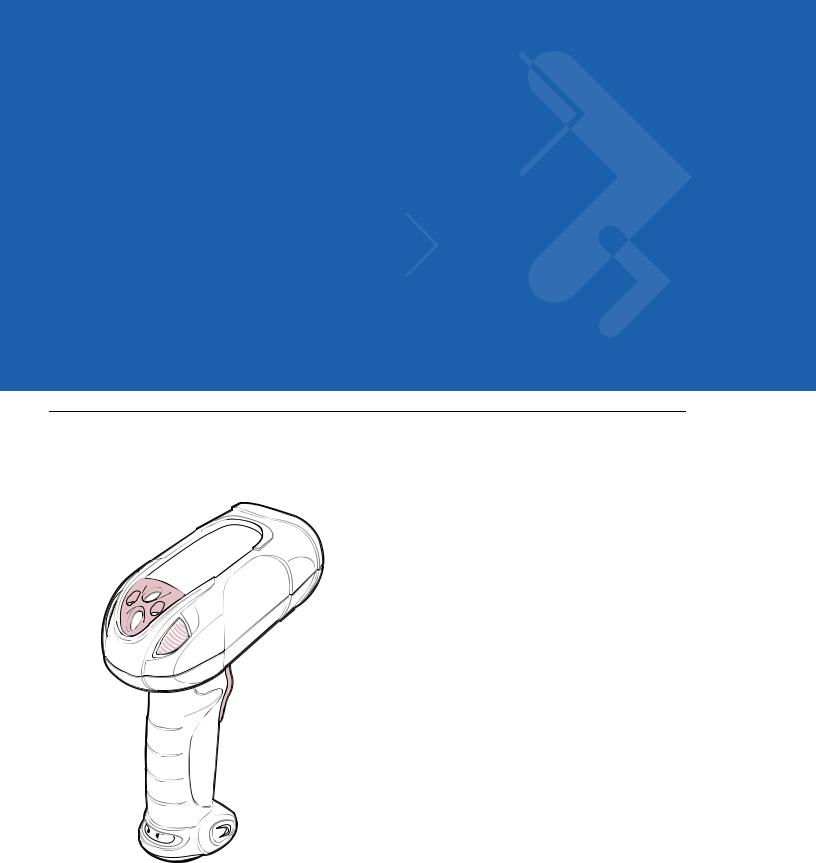
Chapter 1 Getting Started
Introduction
The Symbol LS3478 scanner combines excellent scanning performance and advanced ergonomics to provide the best value in a lightweight laser scanner, ensuring comfort and ease of use for extended periods of time.
Figure 1-1 Symbol LS3478 Scanner
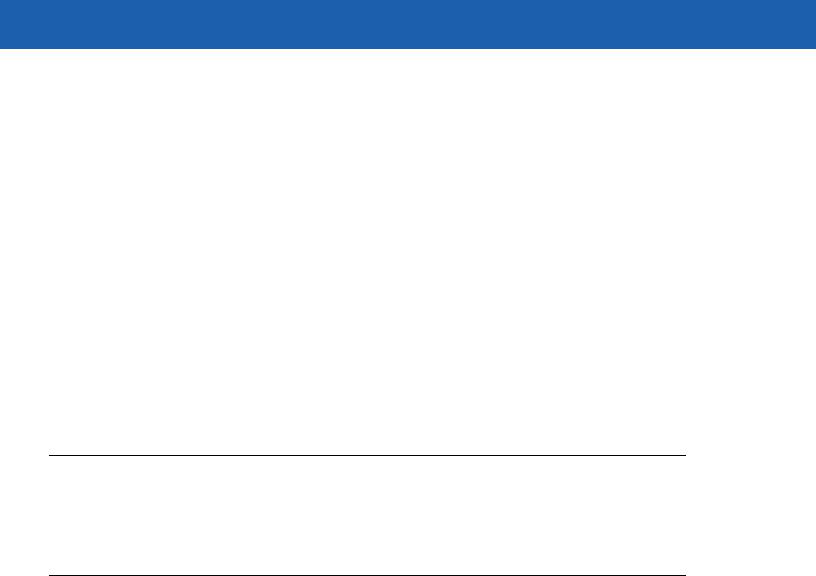
1 - 2 Symbol LS3478 Product Reference Guide
This scanner supports the following host interfaces through communication with a cradle:
•Standard RS-232 connection to a host.
•Keyboard wedge connection to a host, where scanned data is interpreted as keystrokes. The following international keyboards are supported (for Windows™ environment): North American, German, French, French Canadian, Spanish, Italian, Swedish, UK English, Japanese, and Brazilian-Portuguese.
•Wand emulation connection to a mobile computer, a controller, or host, which collects the data as wand data and decodes it.
•Scanner emulation connection to a mobile computer or a controller, which collects the data and interprets it for the host.
•IBM® 468X/469X hosts.
•USB connection to a host. The scanner autodetects a USB host and defaults to the HID keyboard interface type. Select other USB interface types by scanning programming bar codes. The following international keyboards are supported (for Windows™ environment): North America, German, French, French Canadian, Spanish, Italian, Swedish, UK English, Japanese, and Brazilian-Portuguese.
•Synapse capability, which allows connection to a wide variety of host systems using a Synapse cable and Synapse adapter cable. The scanner autodetects the Synapse interface.
•Configuration via 123Scan.
Unpacking the Scanner
Remove the scanner from its packing and inspect it for damage. If the scanner was damaged in transit, call Motorola Enterprise Mobility Support at one of the telephone numbers listed on page xv. KEEP THE PACKING. It is the approved shipping container and should be used if the equipment ever needs to be returned for servicing.
The Scanner Cradle
The scanner cradle serves as a stand, charger, and host interface for the scanner. There are two versions of the cradle:
•Charging cradle with radio: All communication between the cordless scanner and the host computer is accomplished through the cradle. Each bar code contains programming instructions or other data unique to the bar code pattern. The scanner transmits bar code data to the cradle via a wireless radio antenna. The cradle then sends that information via an interface cable to the host computer for interpretation.
•Charge-only cradle: This cradle serves as a stand and battery charger. Since one radio-enabled cradle can receive information from up to four scanners, it is possible to have several charge-only cradles.
The charging cradle with radio supports two modes of operation:
•Single point mode: the cradle communicates with one scanner.
•Multipoint mode: the cradle communicates with more than one scanner.
The cradle sits on a desktop or mounts on a non-horizontal surface (such as a wall or forklift), depending on the environment. For more information about mounting options and procedures, refer to the documentation included with the cradle.
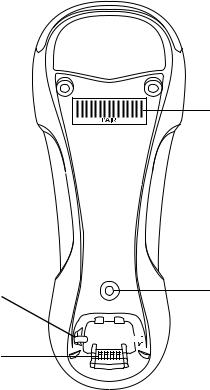
Getting Started |
1 - 3 |
|
|
Cradle Parts
Mounting
Screw Hole 
Latch
Charging/
Communications
Contacts
Figure 1-2 Cradle Front View
Mounting
 Screw Hole
Screw Hole
Pairing
Bar Code
Mounting
Screw Hole
 Latch
Latch
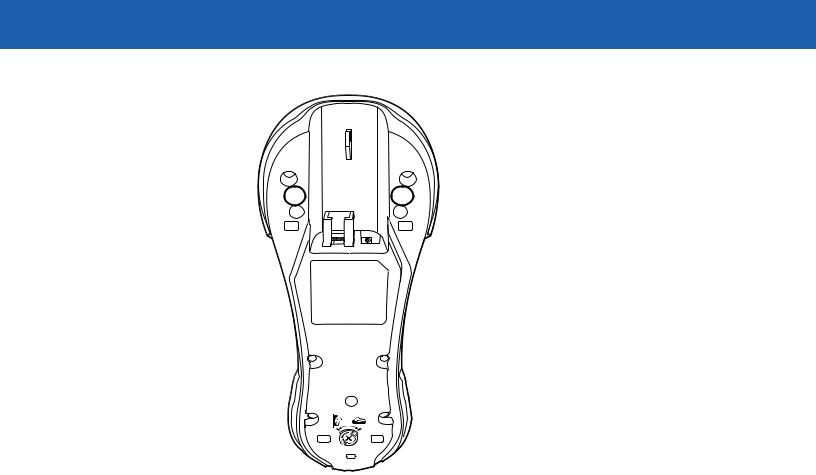
1 - 4 Symbol LS3478 Product Reference Guide
Rubber Foot |
Rubber Foot |
|
|
|
Mounting Screw Hole |
Mounting Screw Hole |
|
Host Port |
Power Port |
Power Cable Groove |
Host Cable Groove |
 Mounting Screw Hole
Mounting Screw Hole
Converter Knob
Rubber Foot 

 Rubber Foot
Rubber Foot
Figure 1-3 Cradle Back View
Connecting the Cradle
Important: Connect the interface cable and power supply in the following order to ensure proper operation of the scanner and cradle. Note that this procedure includes two different power supply options.
1.Disconnect the power supply from the scanner cradle. See Figure 1-4.
2.Insert the modular connector of the interface cable into the host interface port on the back of the scanner cradle.
3.If using a power supply that connects to the interface cable, insert this power supply into the power connector on the interface cable, and the other end to an AC supply (see the cradle’s Quick Reference Guide for more information).
4.Insert the other end of the interface cable into the appropriate port on the host computer (see the specific host chapter for information on host connections).
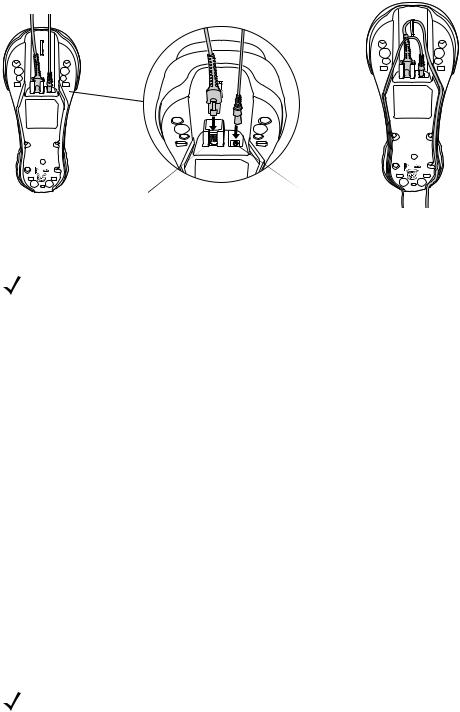
Getting Started |
1 - 5 |
|
|
5.If using an external power supply, insert the power cable into the power port on the back of the scanner cradle, and connect the power supply to an approved AC supply (see the cradle’s Quick Reference Guide for more information).
Host Port |
Power Port |
Figure 1-4 Connecting the Cables to the Cradle
NOTE Disconnect the power supply before changing host cables, or the scanner may not recognize the new host.
Different cables are required for different hosts. The connectors illustrated in each host chapter are examples only. The connectors may be different from those illustrated, but the steps to connect the scanner remain the same.
Supplying Power to the Cradle
The cradle receives power from one of two sources:
•An external power supply.
•When connected to the host through a host cable that supplies power.
The cradle detects whether the host or the external supply is supplying power. It always draws power from the external supply when available, regardless of the presence of power from a host.
Using the USB Interface to Supply Power
When the cradle is connected to the host via the USB interface, it can be powered by the USB port instead of an external power supply. Powering from a USB host limits charging as follows:
•The scanner charges at a slower rate than when charging from an external power supply.
•The cradle can charge a scanner only in single point mode. An external power supply is required to charge a scanner in multipoint mode.
NOTE The radio link functions normally when the cradle draws power from a USB host.
For more information on single and multipoint operation, see Pairing on page 1-9.
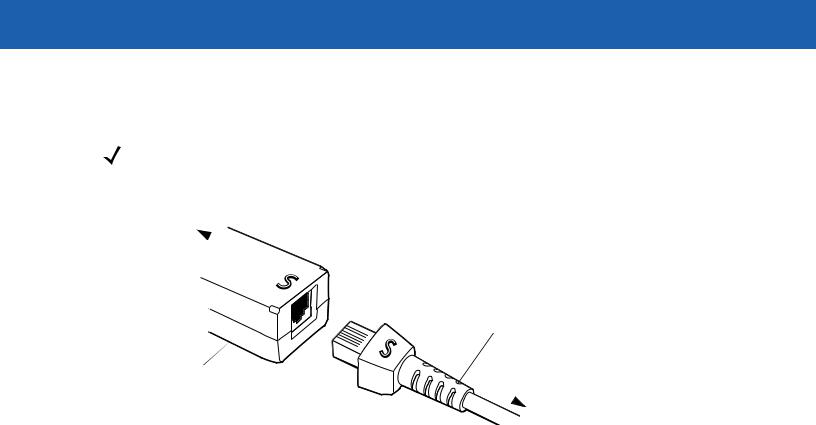
1 - 6 Symbol LS3478 Product Reference Guide
Connecting a Synapse Cable Interface
NOTE Refer to the Synapse Interface Guide provided with the Synapse cable for more information.
Symbol’s Synapse Smart Cables enable interfacing to a variety of hosts. The appropriate Synapse cable detects the host.
To host 
Synapse adapter cable
Synapse Smart Cable
To scanner cradle
Figure 1-5 Synapse Cable Connection
1.Plug the Synapse adapter cable into the bottom of the scanner cradle, as described in Connecting the Cables to the Cradle on page 1-5.
2.Align the ‘S’ on the Synapse adapter cable with the ‘S’ on the Synapse Smart Cable and plug the cable in.
3.Connect the other end of the Synapse Smart Cable to the host.
Lost Connection to Host
If scanned data does not transmit to the cradle’s host, ensure all cables are firmly inserted and the power supply is connected properly. If scanned data still does not transmit to the host, reestablish connection with the host:
1.Disconnect the power supply from the cradle.
2.Disconnect the host interface cable from the cradle.
3.Wait three seconds.
4.Reconnect the host interface cable to the cradle.
5.Reconnect the power supply to the cradle.
6.Re-establish pairing with the cradle.
Mounting the Cradle
For information on mounting the cradle, refer to the documentation included with the cradle.
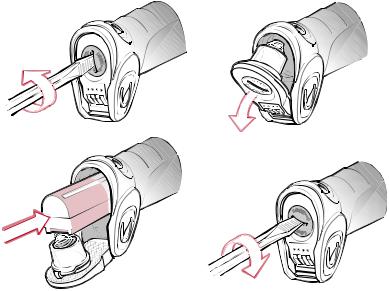
|
Getting Started |
1 - 7 |
|
|
|
|
|
|
|
|
|
Inserting the Battery
The battery resides in a chamber in the scanner handle. To insert the battery:
1.Insert a coin or flathead screwdriver in the slot at the base of the scanner, then turn the slot counterclockwise to release the latch.
2.Lift the latch.
3.If a battery is already installed, turn the scanner upright to slide the battery out.
4.Slide the new battery into the chamber, with the rounded side toward the back and the contacts facing into the chamber.
Figure 1-6 Inserting the Battery
5.Close the latch.
6.Insert a coin or flathead screwdriver in the slot at the base of the scanner, press down gently, and turn the slot clockwise to lock the latch in place.
Removing the Battery
To remove the battery:
1.Insert a coin or flathead screwdriver in the slot at the base of the scanner, then turn the slot counterclockwise to release the latch.
2.Lift the latch.
3.Turn the scanner upright to slide the battery out.

1 - 8 Symbol LS3478 Product Reference Guide
Charging the Battery
For best performance, fully charge the scanner battery before using the scanner for the first time. To charge the battery, place the scanner in the cradle, ensuring that the metal contacts on the bottom of the scanner touch the contacts on the cradle. The battery begins charging. A complete charge can take up to four hours, depending on the remaining charge in the battery.
Charge within the recommended temperature of 32° to 104° F (0° to 40° C) nominal, 41° to 95° F (5° to 35° C) ideal.
For information on maximizing battery life, see Battery Maintenance on page 3-1.
Charging LED
The flashing green LED indicates charging activity. See Table 2-2 on page 2-3. If the scanner is charging in fast mode (external power supply is present), the green LED blinks quickly (on for 0.25 seconds, off for 0.75 seconds). If the scanner is charging in slow mode (host-powered mode), the LED blinks slowly (on for 0.5 seconds, off for 1.5 seconds).
Charging Problem LED
A solid or flashing red LED during charging indicates a charging problem. See Table 2-2 on page 2-3 for definitions of error conditions and the appropriate action to take.
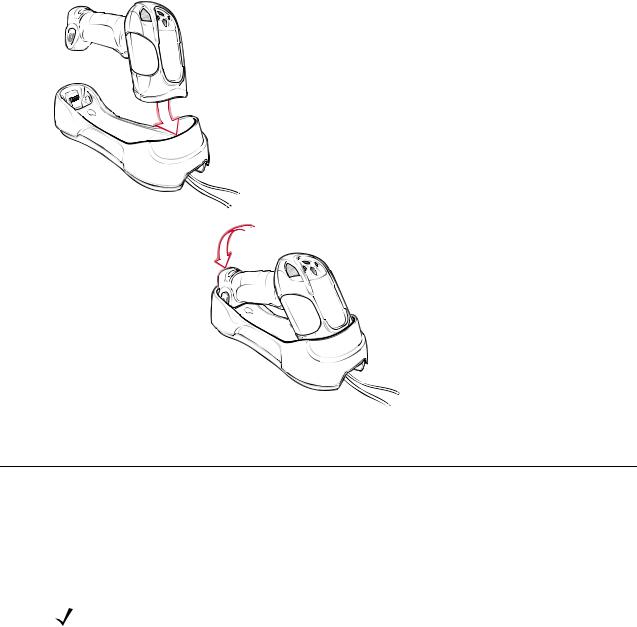
|
Getting Started |
1 - 9 |
|
|
|
|
|
|
|
|
|
Inserting the Scanner in the Cradle
Insert the scanner in the cradle so that the metal contacts on the bottom of the scanner handle touch the contacts on the cradle:
1.With a slightly rotated motion, insert the scanner into the cradle top first.
2.Push the handle until it clicks into place, engaging the contacts in the cradle and scanner.
Figure 1-7 Inserting the Scanner in the Cradle
Pairing
Pairing is the process by which a scanner initiates communication with a cradle. The cradle has multipoint capability, and can pair with up to four scanners at a time. The cradle includes a pairing bar code.
To pair the scanner with the cradle, scan the pairing bar code on the cradle. A short low-high beep indicates successful pairing.
NOTE The pairing bar code that connects the scanner to a cradle is unique to each cradle. Do not scan data or parameters until pairing completes.

1 - 10 Symbol LS3478 Product Reference Guide
Unpairing
Unpair the scanner from the cradle to make the cradle available for pairing with another scanner. Scan the bar code on page 4-12 to unpair the scanner from its cradle.
NOTE An unpairing bar code is also included in the LS3478 Quick Start Guide.
Configuring the Scanner
Use the bar codes in this manual or the 123Scan configuration program to configure the scanner. See Chapter 4, User Preferences and each host chapter for information about programming the scanner using bar code menus. See Chapter 11, 123Scan to configure the scanner using this configuration program. 123Scan includes a help file.
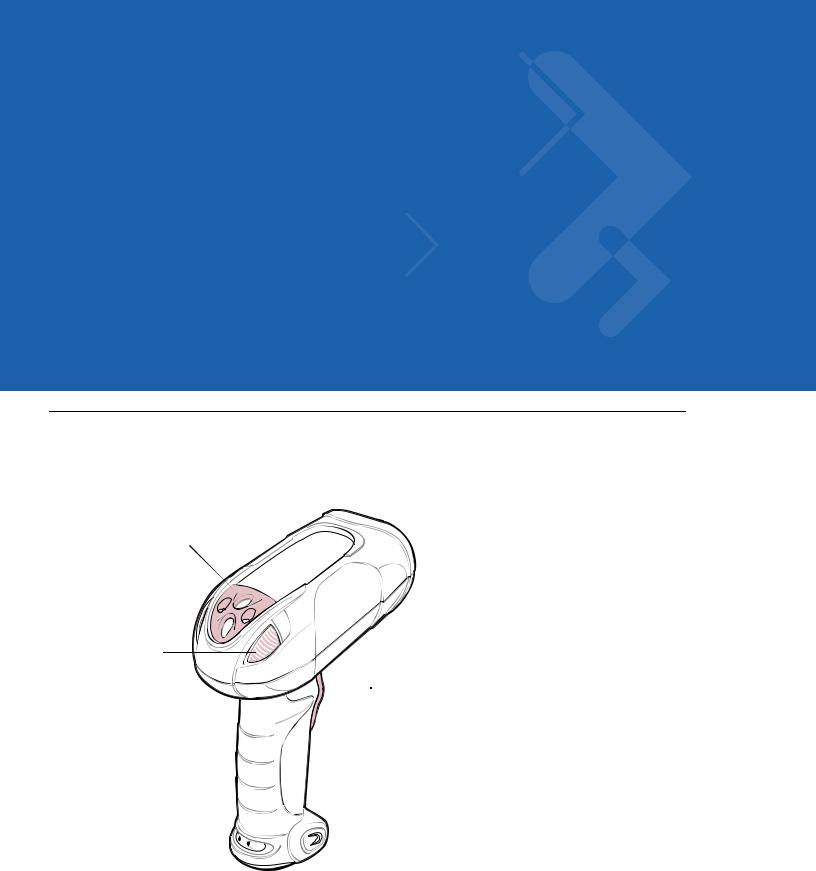
Chapter 2 Scanning
Introduction
This chapter provides beeper and LED definitions, scanning techniques, general scanning instructions and tips, and decode zone diagrams.
 Scan Window
Scan Window
Tether Plate
LED
Indicators
 Scan Trigger
Scan Trigger
Figure 2-1 Parts of the Scanner

2 - 2 Symbol LS3478 Product Reference Guide
Beeper Definitions
The scanner emits different beeper sequences and patterns to indicate its status. Table 2-1 defines beep sequences that occur during both normal scanning and while programming the scanner.
Table 2-1 Standard Beeper Definitions
Beeper Sequence |
Indication |
|
|
Standard Use |
|
|
|
Short low-short medium-short high beeps |
Power up. |
|
|
One short high beep |
A bar code symbol was decoded (if decode beeper is enabled). |
|
|
Four long low beeps |
A communication error occurred while transmitting a scanned symbol |
|
to a host. The data is ignored. This occurs if the scanner is not properly |
|
configured or if the scanner has disconnected from the cradle. |
|
|
Long low-high beeps |
Attempt to pair with the cradle was unsuccessful. Ensure that the |
|
cradle has power; if not, cycle power to the cradle and re-attempt the |
|
pairing. |
|
|
Four short high beeps |
Low battery indication. |
|
|
Long low-high-low-high beeps |
Attempt to pair with a cradle that is already paired with the maximum |
|
number of scanners. |
|
|
Five long low beeps |
Conversion or format error. |
|
|
Low-high-low beeps |
ADF transmit error. |
|
|
Short high-short high-short low-short low |
Radio failure. |
beeps |
|
|
|
Cordless Scanner Connection |
|
|
|
Short low-short high beeps |
The scanner has connected to the cradle after scanning a pairing bar |
|
code or automatically after a disconnect. |
|
|
Short high-short low beeps |
The scanner disconnected from the cradle either because the scanner |
|
moved out of range of the cradle, the USB host suspended the cradle, |
|
or cradle power was interrupted. |
|
|
Parameter Menu Scanning |
|
|
|
Short high beep |
Correct entry scanned or correct menu sequence performed. |
|
|
Long low-long high beeps |
Input error; incorrect bar code, programming sequence or ‘Cancel’ |
|
scanned. Scanner remains in ADF program mode. |
|
|
Short high-short low beeps |
Keyboard parameter selected. Enter value using numeric bar codes. |
|
|
Short high-short low-short high-short low |
Successful program exit with change in the parameter setting. |
beeps |
|
|
|
